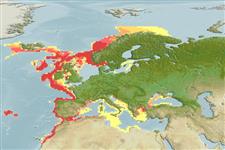Preferred temperature (Ref.
115969): 6.3 - 11.4, mean 7.7 (based on 165 cells).
Phylogenetic diversity index (Ref.
82804): PD
50 = 0.7520 [Uniqueness, from 0.5 = low to 2.0 = high].
Bayesian length-weight: a=0.00479 (0.00375 - 0.00610), b=3.10 (3.03 - 3.17), in cm Total Length, based on LWR estimates for this species (Ref.
93245).
Nível Trófico (Ref.
69278): 4.3 ±0.1 se; based on diet studies.
Resiliência (Ref.
120179): Médio, tempo mínimo de duplicação da população 1,4 - 4,4 anos (K=0.13; tm=2-4; Fec = 26,522; tmax=16).
Prior r = 0.41, 95% CL = 0.27 - 0.62, Based on 9 full stock assessments.
Fishing Vulnerability (Ref.
59153): High vulnerability (60 of 100).
Climate Vulnerability (Ref.
125649): Low vulnerability (25 of 100).
